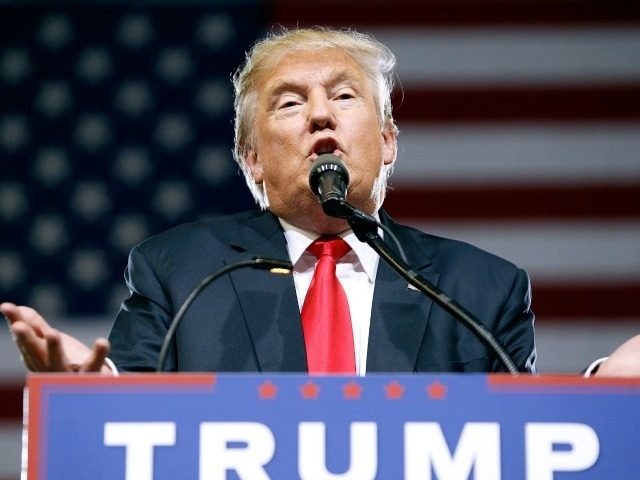Donald Trump’s campaign raised just over $5 million in May, according to recent filings with the FEC. Roughly $2 million of that amount was a loan from Trump.
The campaign spent just over $6 million for the month and began June with just $1.2 million in the bank.
Hillary Clinton raised over $26 million in May and spent around $14 million. At the beginning of June, Clinton had more than $42 million in the bank.
The Trump campaign put out a statement on the fundraising report.
The month of June represents the first full month of fundraising activity for the campaign and this will be reflected in the June FEC report. The campaign held its first campaign fundraising event on May 25th, 2016. To date, the campaign’s fundraising has been incredible and we continue to see a tremendous outpouring of support for Mr. Trump and money to the Republican Party. The positive response to our fundraising efforts so far is a further indication that the country does not want yet another corrupt politician like Crooked Hillary.
Donald Trump essentially wrapped up the Republican primary the day after the Indiana primary on May 3. Within 48 hours of the primary vote in the Hoosier State, all primary challenges to Trump dropped out of the race. So, for almost the entire month of May Trump was the presumptive Republican nominee for President.
His polling numbers received a big boost as he won the primary and several polls showed him pulling ahead of Clinton, who remained locked in her own primary fight.
Instead of capitalizing on this, it seems the Trump campaign took its foot off the gas. Its monthly fundraising in May was lower than any other month this year. Ordinarily candidates are able to raise more money after they secure the nomination. Four years ago Mitt Romney’s fundraising doubled after he won the necessary delegates to claim the nomination. John McCain’s fundraising also jumped after he won the 2008 GOP nomination.
Even Trump’s personal loans to his campaign shrunk dramatically last month. His loan of $2 million to the campaign in May was lower than the $7.5 million in April, $11.5 million in March, $6.8 million in February and $4.9 million in January he gave to his campaign.
Trump’s primary win has proven that raising the most money doesn’t guarantee victory in an election. Several Republican candidates outraised and outspent Trump during the primary. His almost preternatural ability to garner free media allowed his campaign to forgo expensive TV advertising. His ability to attract large crowds to rallies obviated the need for a lot of expensive ground operations to turn out voters.
While those tactics worked in the primary, they are likely to be a lot less effective in the general election. Primaries involve a subset of the electorate that is more politically engaged than the general public. Cable news is very effective at reaching primary voting audiences, but not as good reaching the broader electorate.
In addition, both Clinton and Trump will attract countless hours of press coverage and earned media, negating Trump’s ability in the primary to crowd out his other challengers. Coverage of Trump in the political press will be about equal to coverage of Clinton.
There is another critical difference between the primary and general election. The primary is a series of state contests run consecutively. The general is a series of state contests run simultaneously. One can’t just move a campaign structure and staff from state to state as elections occur. A campaign has to have the resources, staff and infrastructure to battle in more than a dozen swing states at the same time.
To be successful, a campaign needs to be building out its field staff and campaign structure as soon as possible. A large number of states, and the White House, will likely be decided by just 1-3 points in November, making early outreach critical.
November may be be more than 4 months away, but the election isn’t. A handful of states begin early voting for President in just 90 days. In another basket of states, voting begins in early October.
Poor fundraising isn’t just a Trump campaign phenomenon, though.
The GOP faces the challenge of equally horrible fundraising by the Republican National Committee. The RNC raised just $13 million in May, only slightly higher than it raised in May last year, before the election season hit full-stride. The party had just $19 million cash on hand at the end of May, even though the primary campaign had ended at the beginning of the month.
By contrast, the RNC raised $35 million in May 2012 and had some $60 million in the bank. The party raised $25 million in May 2008 and had more than $53 million cash on hand.
Obviously, each election is different and parties face specific challenges each year. By any standard of comparison, though, RNC fundraising is abysmal compared to the last two elections. Its fundraising in May was 50-65 percent less than in 2008 and 2012. It has less than one-third the cash it had in 2012.
The GOP spent less than it did at this time in 2008 and only slightly higher than it did in May 2012. It doesn’t have a lot to show for that, though. The party has 50 full-time field staff in Ohio, a critical battleground state. The Democrats, however, have over 150.
In recent weeks, the RNC has had to calm state Republican party chairmen, upset the GOP hasn’t met promised goals to deploy field staff in battleground states.
Hillary Clinton is a deeply unpopular candidate, but she has amassed a formidible campaign apparatus around her. Trump has around 30 full-time staffers on his campaign. Clinton has 700. She has the media, of course, on her side. Now, though, she also began June with a 42-1 cash advantage over Trump.

COMMENTS
Please let us know if you're having issues with commenting.